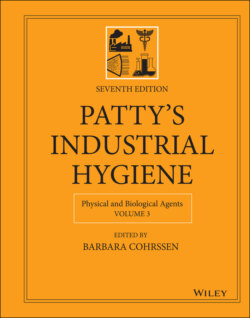Читать книгу Patty's Industrial Hygiene, Physical and Biological Agents - Группа авторов - Страница 75
2.3 Radiance
ОглавлениеSince the rays emitted from a laser are relatively parallel and do not diverge as the laser moves through space, the light energy remains concentrated and retains its characteristic brightness. This concentration of the beam causes the laser brightness to be very much greater than the brightness of any other man‐made light source. A small 1.0‐milliwatt (mW) helium‐neon laser or diode laser pointer used in a lecture hall is typically ten times brighter than the sun. The high brightness means that high concentrations of energy can be achieved when the laser beam is focused to a small spot. The resulting concentration of light energy, if absorbed, (Figure 4) can elevate the temperature at the focus to extremely high levels which can burn or melt materials. It is this phenomenon that makes the laser both a useful surgical or material processing device and a hazardous source of light.
Under certain circumstances, when the laser light is concentrated to an extremely high level, the atoms in the focal zone of the laser beam can be ionized because the electromagnetic energy field is sufficiently intense to strip the electrons from outer atomic shells and directly ionize matter. This forms a spark referred to as an “optical plasma” which can be used to cut normally transparent structures including biological tissues (e.g. as used in the Nd:YAG ophthalmic laser photodisruptor for eye surgery) (10).
FIGURE 4 Radiance. The light from a laser can be totally collected by a lens and focused on a far smaller spot than can the light from a conventional optical source. This smaller focal spot of the laser contains far more concentrated light (a higher irradiance) than the focal spot of a conventional light source. Laser materiel processing and surgical applications, as well as fiber communications, rely on this property.
